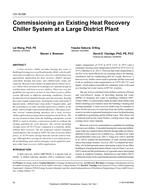Description
A heat recovery chiller provides heating hot water tobuildings by using recovered heat from the chiller, which is efficient and cost-effective. However, not every central plant is an appropriate application for heat recovery chillers because coincident heating hot-water and chilled-water loads are required. Most previous studies on applications of heat recovery chillers have focused on techniques for optimal design of a utility plant with heat recovery chillers. There are very few guidelines for operators on how to run a heat recovery chillersystem efficiently at different operating conditions. Factorsinclude electricity demand charges and rate structure, heating hot-water supply temperature, heating hot-water loop delta-T degeneration, chilled-water loop delta-T degeneration, andthe performance of other variable-speed drive chillers in the plant, which all affect operational efficiency. This paper presents several commissioning measures for a heat recovery chiller application at a large district plant in central Texas. Theon-site measured data from the building automation system(BAS) is used to develop a regression model to evaluate the savings potential for each measure. The current operating strategy saves $270,375/year compared to a baseline chiller without heat recovery, but the proposed control strategies would improve the savings to $389,182/year at current utility prices, or 43.9% more savings than the current control strategy. Although these savings are based on a case-study project, the methodology and control strategies can be applied to optimize other heat recovery chiller applications.
Citation: 2018 Winter Conference, Chicago, IL, Technical Papers
Product Details
- Published:
- 2018
- Number of Pages:
- 9
- Units of Measure:
- Dual
- File Size:
- 1 file , 2.3 MB
- Product Code(s):
- D-CH-18-006




